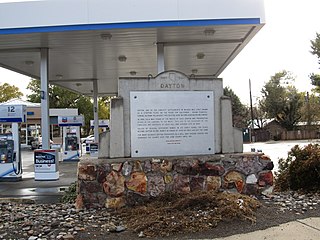
Dayton is an unincorporated community and census-designated place (CDP) in Lyon County, Nevada, United States. The population was 15,153 at the 2020 census. Dayton is the second oldest Nevada settlement. It is home to the oldest hotel in Nevada.

The California State Railroad Museum is a museum in the California State Parks system that interprets the role of railroads in the West. It is located in Old Sacramento State Historic Park at 111 I Street, Sacramento, California.

The Virginia and Truckee Railroad is a privately owned heritage railroad, headquartered in Virginia City, Nevada. Its private and publicly owned route is 14 miles (23 km) long. When first constructed in the 19th century, it was a commercial freight railroad which was originally built to serve the Comstock Lode mining communities of northwestern Nevada.
The Carson and Colorado Railway was a U.S. 3 ft narrow gauge railroad that ran from Mound House, Nevada, to Keeler, California, below the Cerro Gordo Mines. It was incorporated on May 10, 1880, as the Carson and Colorado Railroad, and construction on the railroad began on May 31, 1880. The narrow gauge track was chosen to reduce cost. Much of the route now parallels U.S. Route 95 Alternate, U.S. Route 95, Nevada State Route 360, U.S. Route 6, and U.S. Route 395.

Mound House is a small unincorporated community in Lyon County, Nevada on U.S. Route 50 that is situated between Nevada's capital, Carson City, and Dayton. Its elevation is 4,974 feet (1,516 m). It is in Lyon County, one of eight Nevada counties that allow for legalized prostitution, and is home to four brothels.

Soo Line 2719 is a 4-6-2 "Pacific" type steam locomotive built by the American Locomotive Company (ALCO) for use on passenger trains operated by the Minneapolis, St. Paul and Sault Ste. Marie Railway. No. 2719 was used to haul the Soo Line's last steam-powered train, a June 21, 1959 round-trip excursion between Minneapolis, Minnesota and Ladysmith, Wisconsin. It was then displayed in Eau Claire, Wisconsin until 1996. It was restored and operated in excursion service from 1998 until 2013 when its boiler certificate expired. Today, the locomotive remains on static display in Duluth, Minnesota.

Silver City is a Census Designated Place and small residential community in Lyon County, Nevada, USA, near the Lyon/Carson border. The population as of the 2020 census was 155.

The Jupiter was a 4-4-0 steam locomotive owned by the Central Pacific Railroad. It made history when it joined the Union Pacific No. 119 at Promontory Summit, Utah, during the golden spike ceremony commemorating the completion of the first transcontinental railroad in 1869.
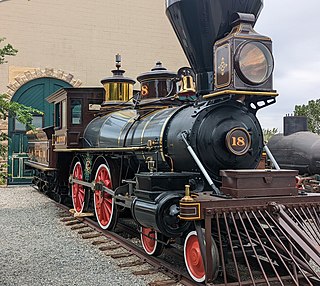
The Virginia and Truckee 18 Dayton is a historic standard gauge steam locomotive on display in Sacramento, California. It spent its working life on the Virginia and Truckee Railroad.

Union Pacific No. 119 was a 4-4-0 American type steam locomotive made famous for meeting the Central Pacific Railroad's Jupiter at Promontory Summit, Utah, during the Golden Spike ceremony commemorating the completion of the first transcontinental railroad in 1869. The locomotive was built by Rogers Locomotive and Machine Works of Paterson, New Jersey in 1868, along with numbers 116, 117, 118 and 120. The original was scrapped in 1903, but a replica now operates at the Golden Spike National Historical Park.
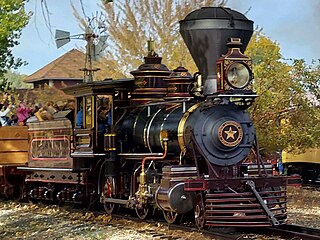
Glenbrook is a 2-6-0, Mogul type, narrow-gauge steam railway locomotive built by Baldwin Locomotive Works in 1875 for the Carson and Tahoe Lumber and Fluming Company's 3 ft Lake Tahoe narrow-gauge railroad.

AbrahamVan Santvoord Curry is considered the founding father of Carson City, Nevada. A native of the state of New York, he traveled to the West Coast during the California Gold Rush and settled in Nevada's Eagle Valley, where Carson City was established.
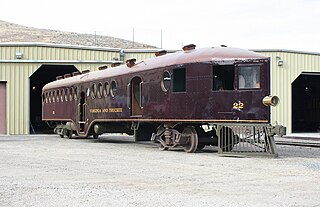
Virginia and Truckee Railway Motor Car 22, also called McKeen Motor Car 70, is a gasoline-powered railcar at the Nevada State Railroad Museum in Carson City in the U.S. state of Nevada. It was built for the Virginia and Truckee Railroad in 1910 by the McKeen Motor Car Company. Motor Car 22 was operated by the Virginia and Truckee until 1945, when it was sold off and became a diner until 1955. It eventually became the office and storage space for a plumbing business before it was donated to the Nevada State Railroad Museum in 1995. After a thorough study, the Museum undertook a restoration of the McKeen car in 1997. The restored motor car was unveiled in 2010, a century after it was originally delivered to the Virginia and Truckee. Motor Car 22 was listed on the National Register of Historic Places in 2005, and designated a National Historic Landmark in 2012. It is one of a few surviving McKeen railcars, and the only one that is operational.
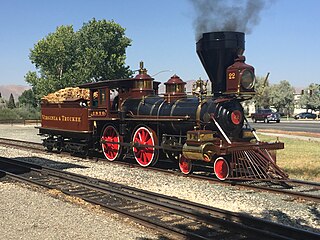
Virginia and Truckee Railroad No. 22, also known as the "Inyo", is a 4-4-0 "American" type steam locomotive that was built by the Baldwin Locomotive Works in 1875 and pulled both passenger and freight trains. The Inyo weighs 68,000 lb (31,000 kg). Its 57 in (140 cm) driving wheels deliver 11,920 lb (5,410 kg) of tractive force. In 1877 it was fitted with air brakes and in 1910 it was converted to burn oil rather than wood.
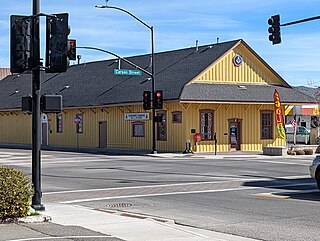
The Virginia & Truckee (V&T) Railroad Depot of Carson City, Nevada, is a historic railroad station that is listed on the U.S. National Register of Historic Places (NRHP). It is significant for its association with the economically important role of the V&T railroad historically in Carson City following discovery of the Comstock Lode mine in 1859. To a lesser degree, according to its NRHP nomination, the depot building is also significant architecturally "as a well-preserved example of a wood-frame passenger depot procured from a railroad company pattern book within the V&T's former sphere of operation."
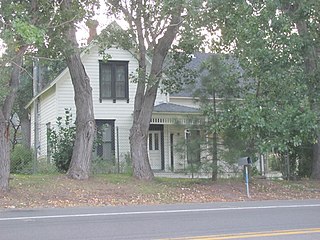
Nevada State Historic Preservation Office PDF documents

The Carson and Tahoe Lumber and Fluming Company (C&TL&F) was formed to move lumber from trees growing along the shore of Lake Tahoe to the silver mines of the Comstock Lode. Between 1872 and 1898 C&TL&F transferred 750 million board foot of lumber logged from 80,000 acres (32,000 ha) of virgin timberland.

McCloud Railway No. 18 is a 2-8-2 "Mikado" type steam locomotive built by Baldwin Locomotive Works. The locomotive was purchased new by the McCloud River Railway Company in 1914 as a standalone purchase. No. 18 was bought by the Yreka Western Railroad in 1956 and bought back by the McCloud in 1998. It was restored to operation in McCloud during 1998 and operated there until it was sold in 2005 to Virginia and Truckee Railroad.
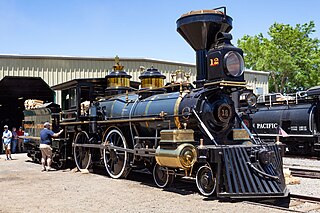
Virginia and Truckee Railroad No. 12, nicknamed Genoa, is a 4-4-0 American steam locomotive built by the Baldwin Locomotive Works in January 1873 for the Virginia and Truckee Railroad. She is one of three largely identical 4-4-0 locomotives built by Baldwin for the railroad, the others being the Reno and the Inyo, and one of four V&T 4-4-0's preserved.
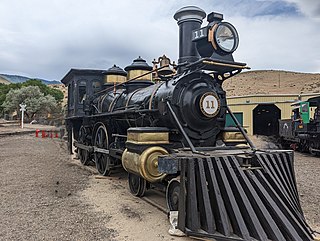
Virginia and Truckee Railroad No. 11, the "Reno", is a surviving 4-4-0, "American"-type steam locomotive. It is one of three largely identical 4-4-0 locomotives built by Baldwin for the railroad, the others being the Genoa and the Inyo, and one of four V&T 4-4-0's preserved. The engine is one of Hollywood's most prodigious Flanged Star, starring in over 120 films, commercials, and television episodes starting in 1937. Today, the 2nd oldest surviving example of the Baldwin 4-4-0 type is undergoing restoration at her original home in Virginia City, Nevada.




















